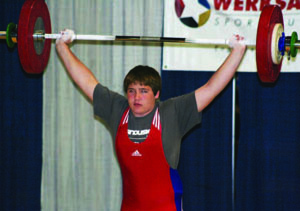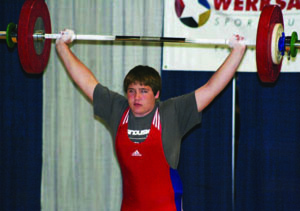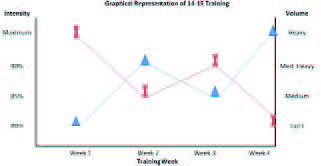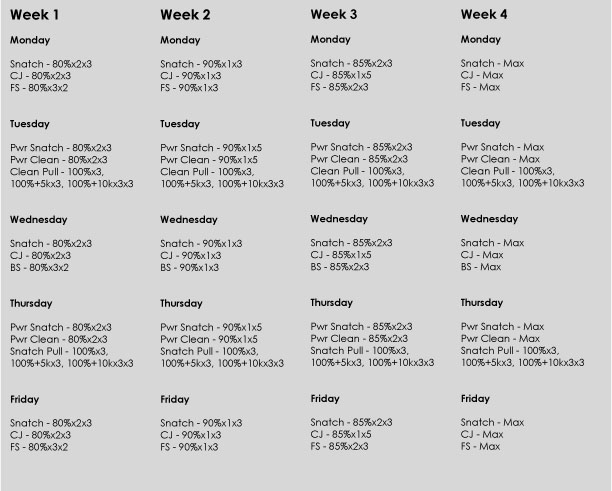14-15 Training Program

This month the training moves into the third program known as the “14-15 training program.” To begin let’s recap on the previous two programs to make sure the goals were accomplished before moving onto even more specialized training. In the beginner program the goal was to teach the lifts in a manageable way as well as to begin to build snatch and clean and jerk specific strength. The goal of 13&U training was to incorporate more full lifts, the power versions, pulls and with the use of certain teaching aids (lifts above knee and jerks from the rack) continue learning the snatch and clean and jerk. With completion of these two programs, taking approximately three years, the move to more specialized training is appropriate.
The 14-15 program represents a turning point in our training system. First, it becomes increasingly specialized as the total number of exercises has once again been reduced this time from ten to eight. The lifts from above the knees have been eliminated along with the jerk from rack and the back squat has been added. Second, we have added a fifth day of training maxing out the number of training days we have to train the school age lifters (weekends are for them unless there is a contest).
TABLE 1.1
Once again, before going into specifics with regards to the training weeks we should first look at the summary table 1.1 of the training program. Comparing this summary table to the one for the 13&U it can be seen that the intensity of training for each week is exactly the same as it was for the 13&U. There is a logical reason for this; with the addition of a fifth day of training volume increases no matter what, even with the reduction of repetitions done per set as will be seen later. I feel it would be too much of a shock to the system per se, to both add the fifth day (which is more full lifts) and at the same time increase the overall intensity. In my opinion this is where many people fail when trying a “Bulgarian” type training system. They dive into it without allowing proper time to adapt to it and when they hit the wall they blame the system instead of their own ignorance. Both Christos Iakovou (GRE) and Ivan Abadjiev (BUL) have been quoted as saying that it takes many years of specific preparation in order to train as heavy as they do. The pre-school age and school age years are part of that preparation and it needs to be handled with patience. Therefore by increasing only one of the training factors (intensity or volume), acclamation to the new program should be much smoother.

Focusing now on the volume of training and its distribution leads to some interesting findings. The percentage of the total reps from the classic lifts has increased by 8% from 31% to 39%. Once again this is a quick indicator as to the trend we are moving towards. With the addition of the fifth day of training the total number of reps has also increased by 122 reps from 632 to 754. This occurs even with the reduction of reps in the 80% week from mostly triples to doubles and in the 85% week from doubles to many singles. A final note about the volume of training in this program: This is the highest the volume will be during the school age training. During the next program the volume will be reduced as the intensity is increased. You can imagine these as being the last “prepatory” years of training. After this it gets rough.

Looking at figure 1.1, a graphical representation of the training, it can be seen that it is the exact same as the 13&U graph as nothing has changed in terms of the intensity or the operational definitions of the volume markers; the only change is the addition of the fifth day of training. (When discussing the following programs this graph will provide a nice visualization of the changes that occur in the different programs.)
Getting into the weekly trainings of the workout, a couple general changes have been made that are common to each week. First, there are now three days of squatting with the addition of the day of back squats along with the two days of front squats. Also, the day of lifts above the knee and jerks from the rack have been replaced by a second day of powers and pulls—the pulls are now done twice per week rather than rotating each week between the snatch and clean pulls. Clean pulls are done first during the week so if it is a contest week the heavier version of pulls are not done close to the meet. There is now also a fifth day of training consisting of still more full lifts and squats. During the week of a contest the fifth day is skipped if the contest is on a Saturday, which more than makes up for the missed day. The power days serve as a break during the 90% and 100% weeks as they still force you to put 100% effort into them but the weights are naturally lighter. This way the intensity is maintained while easing up on the joints and muscles slightly.
The warm-up sets listed are a guideline and are used as such; sometimes we use fewer warm-ups but rarely do we use more. When lifting to max we try to get to 90% in less than six lifts usually with circa-90% being set number six. A typical example would be a 14 year old 69kg lifter with best lifts: snatch – 80kg; clean and jerk – 100kg and front squat – 125kg. His workout during max week would look like this:
• Snatch – 40x2, 50x2, 60x1, 65x1, 70x1 (approx. 90%), 75x1, 80x1
• Clean and Jerk – 50x1, 70x1, 80x1, 90x1 (90%), 95x1, 100x1
• Front Squat – 60x1, 90x1, 110x1, 125x1
Little time and energy are wasted. I have seen training programs written that look like math books rather than workouts with an excessive amount of sets being done in the effort to increase the volume of training. Volume is not very important. Intensity is the most important component of training. None of the sets matter in training except the final ones—the ones which require maximum effort. It is of our opinion that if you plan on training at less than 80%, stay at home on the couch and watch lifting; it will do you about as much good.

The 14-15 program represents a turning point in our training system. First, it becomes increasingly specialized as the total number of exercises has once again been reduced this time from ten to eight. The lifts from above the knees have been eliminated along with the jerk from rack and the back squat has been added. Second, we have added a fifth day of training maxing out the number of training days we have to train the school age lifters (weekends are for them unless there is a contest).
| week 1 | Week 2 | Week 3 | Week 4 | Total | % of total Reps | |
| Total reps | 224 | 162 | 206 | 162 | 754 | 100% |
| Classic Lifts Reps | 84 | 66 | 76 | 66 | 292 | 39% |
| Assistance Reps | 140 | 96 | 130 | 96 | 462 | 61% |
| Intensity | 80% | 90% | 85% | 100% |
Once again, before going into specifics with regards to the training weeks we should first look at the summary table 1.1 of the training program. Comparing this summary table to the one for the 13&U it can be seen that the intensity of training for each week is exactly the same as it was for the 13&U. There is a logical reason for this; with the addition of a fifth day of training volume increases no matter what, even with the reduction of repetitions done per set as will be seen later. I feel it would be too much of a shock to the system per se, to both add the fifth day (which is more full lifts) and at the same time increase the overall intensity. In my opinion this is where many people fail when trying a “Bulgarian” type training system. They dive into it without allowing proper time to adapt to it and when they hit the wall they blame the system instead of their own ignorance. Both Christos Iakovou (GRE) and Ivan Abadjiev (BUL) have been quoted as saying that it takes many years of specific preparation in order to train as heavy as they do. The pre-school age and school age years are part of that preparation and it needs to be handled with patience. Therefore by increasing only one of the training factors (intensity or volume), acclamation to the new program should be much smoother.

Focusing now on the volume of training and its distribution leads to some interesting findings. The percentage of the total reps from the classic lifts has increased by 8% from 31% to 39%. Once again this is a quick indicator as to the trend we are moving towards. With the addition of the fifth day of training the total number of reps has also increased by 122 reps from 632 to 754. This occurs even with the reduction of reps in the 80% week from mostly triples to doubles and in the 85% week from doubles to many singles. A final note about the volume of training in this program: This is the highest the volume will be during the school age training. During the next program the volume will be reduced as the intensity is increased. You can imagine these as being the last “prepatory” years of training. After this it gets rough.

Looking at figure 1.1, a graphical representation of the training, it can be seen that it is the exact same as the 13&U graph as nothing has changed in terms of the intensity or the operational definitions of the volume markers; the only change is the addition of the fifth day of training. (When discussing the following programs this graph will provide a nice visualization of the changes that occur in the different programs.)
Getting into the weekly trainings of the workout, a couple general changes have been made that are common to each week. First, there are now three days of squatting with the addition of the day of back squats along with the two days of front squats. Also, the day of lifts above the knee and jerks from the rack have been replaced by a second day of powers and pulls—the pulls are now done twice per week rather than rotating each week between the snatch and clean pulls. Clean pulls are done first during the week so if it is a contest week the heavier version of pulls are not done close to the meet. There is now also a fifth day of training consisting of still more full lifts and squats. During the week of a contest the fifth day is skipped if the contest is on a Saturday, which more than makes up for the missed day. The power days serve as a break during the 90% and 100% weeks as they still force you to put 100% effort into them but the weights are naturally lighter. This way the intensity is maintained while easing up on the joints and muscles slightly.
The warm-up sets listed are a guideline and are used as such; sometimes we use fewer warm-ups but rarely do we use more. When lifting to max we try to get to 90% in less than six lifts usually with circa-90% being set number six. A typical example would be a 14 year old 69kg lifter with best lifts: snatch – 80kg; clean and jerk – 100kg and front squat – 125kg. His workout during max week would look like this:
• Snatch – 40x2, 50x2, 60x1, 65x1, 70x1 (approx. 90%), 75x1, 80x1
• Clean and Jerk – 50x1, 70x1, 80x1, 90x1 (90%), 95x1, 100x1
• Front Squat – 60x1, 90x1, 110x1, 125x1
Little time and energy are wasted. I have seen training programs written that look like math books rather than workouts with an excessive amount of sets being done in the effort to increase the volume of training. Volume is not very important. Intensity is the most important component of training. None of the sets matter in training except the final ones—the ones which require maximum effort. It is of our opinion that if you plan on training at less than 80%, stay at home on the couch and watch lifting; it will do you about as much good.

|
Ryan Kyle is the coach of Sandusky Weightlifting and the strength coach for St. Mary's Central Catholic High School in Sandusky, Ohio. He is a USA Weightlifting club coach and his lifters have medaled at the Youth Pan-American Championships and have been Junior World Team members. |
Search Articles
Article Categories
Sort by Author
Sort by Issue & Date
Article Categories
Sort by Author
Sort by Issue & Date

